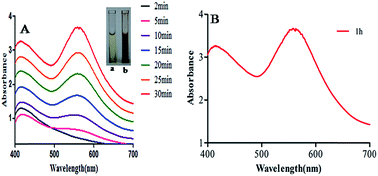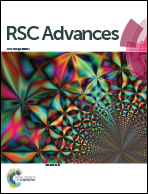Longan fruit juice mediated synthesis of uniformly dispersed spherical AuNPs: cytotoxicity against human breast cancer cell line MCF-7, antioxidant and fluorescent properties
Abstract
The development of a biologically glorious experimental process for the synthesis of nanoparticles is an important emerging branch of nanotechnology. Gold nanoparticles (AuNPs) can be easily synthesized, functionalized and are biocompatible. In the present work AuNPs were synthesized by an eco-friendly, fast, one-pot and green synthetic route using Longan fruit juice as a reducing, capping and stabilizing agent. The AuNPs showed surface plasmon resonance at around 555 nm. The spherical shape, fine dispersion, average size (25 nm), crystalline structure and elemental composition were characterized by high resolution transmission electron microscopy (HRTEM), X-ray diffraction (XRD) and energy-dispersive X-ray spectroscopy (EDS). The capping and stabilizing molecules were characterized by Fourier transform infrared spectroscopy (FTIR). The AuNPs were found to be unique with respect to mono-structural morphology and greater yield as compared to other bio-synthesized AuNPs. Furthermore, the cytotoxicity of AuNPs proved to be potent agent against human breast cancer cell line MCF-7. AuNPs exhibited significant antioxidant activity and fluorescence emission. These biomaterials can be used for broad biomedical applications.


 Please wait while we load your content...
Please wait while we load your content...